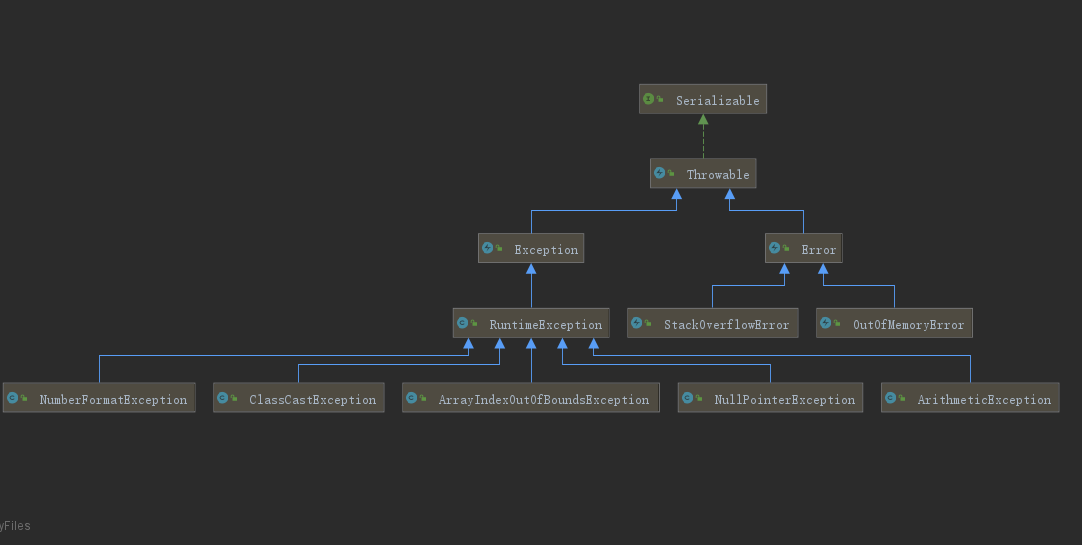1.异常引入
package exception;
@SuppressWarnings({"all"})
/**
* @Author Blueshadow
* @Date 2021/7/30 11:01
* @Version 1.0
*/
public class exception {
public static void main(String[] args) {
//通过try...catch...异常处理机制来处理异常,从而保证程序的健壮性
int a = 10;
int b = 0;
int num = 0;
try {
num = a / b;//尝试执行
} catch (Exception e) {//捕获错误
System.out.println("异常信息是"+e.getMessage());
}
System.out.println("程序继续执行");
System.out.println("num="+num);//程序抛出ArithmeticException异常,程序结束执行
}
}
2.异常介绍
- 为基本概念:Java语言中,将程序执行中发生的不正常现象称为异常,语法错误和逻辑错误不是异常。
- 异常的分类:
- Error:Java虚拟机无法解决的严重问题。如:JVM系统内部错误、资源耗尽等严重情况。比如:栈溢出。Error错误是严重错误,程序会崩溃。
- Exception:其他原因编程错误或偶然的外在因素导致的一般性问题,可以通过针对性的代码进行处理。例如空指针访问,试图读取不存在的文件,网络连接中断等,Exception分为两大类,运行时异常和编译时异常。
3.异常体系

4.五大运行时异常(RuntimeException)
4.1NullPointException空指针异常
当程序试图在需要对象的地方使用null时,抛出该异常。
package exception;
@SuppressWarnings({"all"})
/**
* @Author Blueshadow
* @Date 2021/7/30 11:01
* @Version 1.0
*/
public class exception {
public static void main(String[] args) {
String name = null;
System.out.println(name.length());
//Exception in thread "main" java.lang.NullPointerException
}
}
4.2ArithmeticException数学运算异常
当出现异常的运算条件的时候,抛出该异常。
package exception;
@SuppressWarnings({"all"})
/**
* @Author Blueshadow
* @Date 2021/7/30 11:01
* @Version 1.0
*/
public class exception {
public static void main(String[] args) {
int a = 10;
int b = 0;
int count = a/b;
System.out.println(count);
//Exception in thread "main" java.lang.ArithmeticException: / by zero
}
}
4.3ArrayIndexOutOfBoundsException 数组下标越界异常
用非法索引访问数组时抛出的异常。
package exception;
@SuppressWarnings({"all"})
/**
* @Author Blueshadow
* @Date 2021/7/30 11:01
* @Version 1.0
*/
public class exception {
public static void main(String[] args) {
int[] a = {1,2,3,4,5};
for (int i = 0; i <= a.length; i++) {
System.out.println(a[i]);
//Exception in thread "main" java.lang.ArrayIndexOutOfBoundsException: 5
}
}
}
4.4ClassCastException类型转换异常
当试图将对象强制转换为不是实例的子类时,抛出该异常。
package exception;
@SuppressWarnings({"all"})
/**
* @Author Blueshadow
* @Date 2021/7/30 11:01
* @Version 1.0
*/
public class exception {
public static void main(String[] args) {
A b = new B();//向下转型
B b1 = (B)b;//向下转型
C c2 = (C)b;
//Exception in thread "main" java.lang.ClassCastException: exception.B cannot be cast to exception.C
}
}
class A{}
class B extends A{}
class C extends A{}
4.5NumberFormatException数字格式不正确异常
当程序试图将字符串转换成一种数值类型,但该字符串不能转换为适当格式时,抛出该异常。
package exception;
@SuppressWarnings({"all"})
/**
* @Author Blueshadow
* @Date 2021/7/30 11:01
* @Version 1.0
*/
public class exception {
public static void main(String[] args) {
String str = "Hello world";
int num = Integer.parseInt(str);
//Exception in thread "main" java.lang.NumberFormatException: For input string: "Hello world"
}
}
5.常见编译异常
编译异常是指在编译代码期间就必须进行处理的异常,否则代码不能通过编译
常见的编译异常
SQLException//操作数据库时,查询表可能发生异常
IOException//操作文件时发生的异常
FileNotFoundException//当操作文件,而文件不存在时,发生异常
ClassNotFoundException//加载类,而该类不存在时,发生异常
EOFException//操作文件,到文件末尾,发生异常
IIIegalArguementException//参数异常
6.异常处理机制
6.1处理方式
try-catch-finally//在代码中捕获发生的异常,自行处理
throws//将发生的异常抛出,交给调用者(方法)来处理,最顶级的处理者就是JVM
6.2try-catch-finally
try{
//代码/可能有异常
}catch{
//捕获到异常
//当异常发生时
//当系统将异常封装成Exception对象e,传递给catch
//得到异常对象后自行处理
}finally{
//不论是否有异常,一定会执行的代码块
}
6.3throws异常处理
如果一个方法中可能生成某种异常,但并不能确定如何处理这种异常,则此方法应显示声明抛出异常,表明该方法不对这些异常进行处理,而由该方法的调用者进行处理。
在方法声明中用throws语句可以声明抛出异常的列表,throws后面的异常类型可以是方法中产生的异常类型,也可以是它的父类。
6.4自定义异常
当程序中出现了错误,但是该错误信息并没有在Throwable子类中描述处理,则这个时候可以自己设计异常类,用于描述该错误信息。
package exception;
@SuppressWarnings({"all"})
/**
* @Author Blueshadow
* @Date 2021/7/30 11:01
* @Version 1.0
*
* 案例:在接收Person对象的年龄的时候,要求是在18-120岁之间,否则抛出一个自定义异常,
* 该自定义异常继承RuntimeException
*/
public class exception {
public static void main(String[] args) {
int age = 800;
if (!(age>=18 && age<=120)){
//通过构造器输入异常信息
throw new AgeException("年龄必须在18-120之间");
}
//Exception in thread "main" exception.AgeException: 年龄必须在18-120之间
System.out.println("你的年龄范围正确");
}
}
//自定义异常
class AgeException extends RuntimeException{
public AgeException(String message) {//构造器
super(message);
}
}
//一般情况下自定义异常要继承RuntimeException,即定义成运行时异常,好处是我们可以使用默认的处理机制
6.5throw和throws的区别
| 意义 | 位置 | 后面跟的东西 | |
|---|---|---|---|
| throws | 异常处理的一种方式 | 方法声明处 | 异常类型 |
| throw | 手动生成异常对象的关键字 | 方法体中 | 异常对象 |